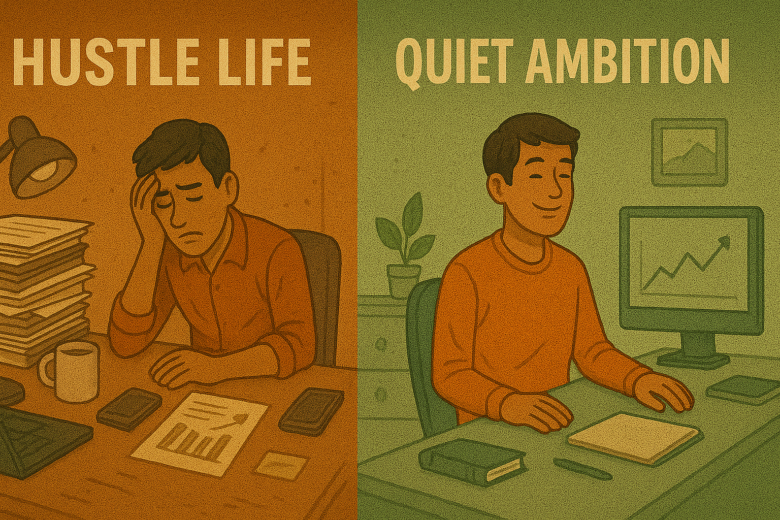Fun fact: The word “hustle” originally meant “to shake or toss”—today, it’s tossing our peace of mind.
For over a decade, “hustle culture” has ruled our timelines and workspaces. It was the mantra of startups, the gospel of self-made millionaires, and the unspoken expectation behind late-night emails. You didn’t just work; you hustled. If you weren’t building a side hustle, chasing multiple streams of income, or grinding until 2 AM, were you even trying?
But now, in quiet pockets across the world—including India’s bustling metros and sleepy towns—something surprising is happening: people are stepping off the hamster wheel. Welcome to the age of quiet ambition, where success looks slower, softer, and, frankly, saner.
From Burnout to Balance: Why the Hustle Feels Hollow
The hustle movement was once thrilling. Inspired by stories from Silicon Valley—where companies like Uber Technologies Inc. (a multinational ride-hailing company) and WeWork (a co-working space provider) promised world-changing innovation—young people worldwide were encouraged to chase massive success fast. Every tweet, podcast, and LinkedIn post seemed to glorify 18-hour days and coffee-fueled dreams.
But beneath the shiny exterior was a darker truth: burnout, anxiety, loneliness, and even depression. In India, a 2023 study by the Indian Psychiatric Society found a 20% rise in mental health issues among working professionals aged 25–35. The so-called dream was exhausting people. And then came the pandemic, a global pause button that made many ask: Is this really worth it?
Redefining Success: Not Slower, Just Smarter
Enter the quietly ambitious. They’re not dropping out of ambition altogether—they’re just defining it differently. It’s not about how fast you rise, but how sustainably you grow. It’s not about visibility; it’s about values.
Meet Priya, a 29-year-old architect from Pune. After working in a high-stakes design firm for five years, she switched to freelancing. “I earn a little less,” she admits, “but I finally sleep eight hours, cook my own meals, and even adopted a dog. That is success to me.”
This shift isn’t about laziness or lack of drive. It’s a form of intentional living. You’ll find these individuals in slow-growing sustainable businesses, government jobs with work-life balance, or even homemakers pursuing online degrees at their own pace.
The Rise of “Soft Life” and Intentional Careers
Search trends don’t lie. According to Google Trends, the phrase “soft life” has seen a 130% increase in India over the past year. The term refers to a lifestyle that values ease, wellness, and emotional richness over endless ambition.
Even social media influencers are pivoting. Creators like The Lazy Millennial (a content page promoting balanced success) or Kusha Kapila, who openly discusses burnout, now have huge followings—not because they flaunt wealth but because they radiate relatability.
Quiet ambition encourages you to:
- Prioritise mental health without guilt.
- Say no to toxic productivity.
- Grow at your own pace—financially, professionally, and emotionally.
- Celebrate behind-the-scenes victories.

Not All Ambition Is Loud: The Myth of Visibility
One of hustle culture’s sneakiest lies was that if no one saw your effort, it didn’t count. You had to constantly post, pitch, and prove.
But not everyone wants to be viral. Some are content making an impact in smaller circles—mentoring interns, supporting their families, or innovating within their communities.
Dr. Rehan, a rural health officer in Uttar Pradesh, has helped digitise medical records in five villages. He’s not tweeting about it. He’s too busy doing the work.
Why Gen Z Is Embracing the Quiet Life
Interestingly, it’s Gen Z (Generation Z)—the very generation raised on YouTube hustle tips and Shark Tank reruns—who are driving this quiet revolution. In multiple surveys, they express a desire for meaningful work, not just profitable work.
A 2024 Deloitte study on Gen Z in India showed that over 65% prioritised purpose, mental well-being, and flexibility over high salaries. The dream job now comes with boundaries and breaks.
This generation watched their Millennial elders work themselves into exhaustion, and they’re choosing differently.
Quiet Doesn’t Mean Complacent
Let’s be clear: quiet ambition doesn’t mean giving up. It’s not a rejection of goals but of the glorification of grind. You can want success and peace. You can be ambitious and take a nap.
It’s the coder who works 9 to 5 and shuts the laptop at 5:01. It’s the artist who paints at midnight, not for Instagram but for joy. It’s the teacher building lives instead of personal brands.
It’s a quiet power—one that doesn’t shout, but stays.
Conclusion: Maybe the Dream Is Changing—and That’s Okay
The return of quiet ambition is not a fad—it’s a correction. After years of hustle fatigue, people are remembering that life isn’t a sprint. It’s a winding walk, and the scenery matters.
This shift isn’t about rebellion. It’s about redesign. We’re no longer chasing the spotlight. We’re choosing to build a life—authentic, unflashy, fulfilled.
So if your ambition feels slower, deeper, quieter, good, you’re not falling behind. You’re moving forward on your own terms.
Author’s Note
I wrote this piece while sipping a warm chai at home on a lazy Sunday afternoon—because ambition doesn’t always have to roar. Sometimes, it just has to feel right.
G.C., Ecosociosphere contributor.
References and Further Reading
- Deloitte India Gen Z and Millennial Survey 2024
- Indian Psychiatric Society – Mental Health and Work-Life Balance Report (2023)




